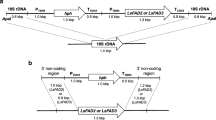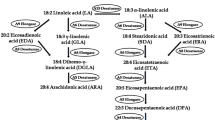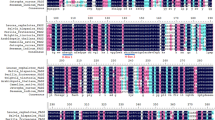Abstract
In modern diet of human being, the ω-6/ω-3 ratio of dietary fatty acid was shifted much towards ω-6 series. In this work, a fatty acid desaturase (FAD) gene lkfad15 was cloned and identified from oleaginous yeast Lipomyces kononenkoae. Function analysis results shown that LKFAD15 is a novel Δ12/Δ15 bifunctional FAD which could not only produce linoleic acid and α-linolenic acid use just oleic acid as substrate but also adjust the ω- 6/ω-3 fatty acids ratio to the WHO recommended ratio. Phylogenetic analysis of LKFAD15 suggested it is a specific intermediate product of gene evolution derives from independent gene duplication events.
Similar content being viewed by others
References
Hwang D. Fatty acids and immune responses — A new perspective in searching for clues to mechanism. Annu. Rev. Nutr. 20: 431–456 (2000)
James MJ, Gibson RA, Cleland LG. Dietary polyunsaturated fatty acids and inflammatory mediator production. Am. J. Clin Nutr. 71: 343S–348S (2000)
Los DA, Murata N. Structure and expression of fatty acid desaturases. Biochim. Biophys. Acta 1394: 3–15 (1998)
Simopoulos AP. Essential fatty acids in health and chronic disease. Am. J. Clin. Nutr. 70: 560S–569S (1999)
Simopoulos AP. The importance of the ratio of ω-6/ω-3 essential fatty acids. Biomed. Pharmacother. 56: 365–379 (2002)
Nishida C, Uauy R, Kumanyika S, Shetty P. The joint WHO/FAO expert consultation on diet, nutrition, and the prevention of chronic diseases: Process, product, and policy implications. Public Health Nutr. 7: 245–250 (2004)
Hussein N, Ah-Sing E, Wilkinson P, Leach C, Griffin BA, Millward DJ. Long-chain conversion of [13C]linoleic acid and α-linolenic acid in response to marked changes in their dietary intake in men. J. Lipid Res. 46: 269–280 (2005)
Arts MT, Ackman RG, Holub BJ. “Essential fatty acids” in aquatic ecosystems: A crucial link between diet and human health and evolution. Can. J. Fish Aquat. Sci. 58: 122–137 (2001)
Liu YG, Chen Y. High-efficiency thermal asymmetric interlaced PCR for amplification of unknown flanking sequences. Biotechniques 43: 649–656 (2007)
ORF Finder Available from: http://www.ncbi.nlm.nih.gov/projects/gorf/. Accessed June 13, 2011.
Marchler-Bauer A, Lu S, Anderson JB, Chitsaz F, Derbyshire MK, DeWeese-Scott C, Fong JH, Geer LY, Geer RC, Gonzales NR, Gwadz M, Hurwitz DI, Jackson JD, Ke Z, Lanczycki CJ, Lu F, Marchler GH, Mullokandov M, Omelchenko MV, Robertson CL, Song JS, Thanki N, Yamashita RA, Zhang D, Zhang N, Zheng C, Bryant SH. CDD: A conserved domain database for the functional annotation of proteins. Nucleic Acids Res. 39: D225–D229 (2011)
Tamura K, Peterson D, Peterson N, Stecher G, Nei M, Kumar S. MEGA5: Molecular evolutionary genetics analysis using maximum likelihood, evolutionary distance, and maximum parsimony methods. Mol. Biol. Evol. 28: 2731–2739 (2011)
Wan X, Zhang Y, Wang P, Huang F, Chen H, Jiang M. Production of gamma-linolenic acid in Pichia pastoris by expression of a Δ-6 desaturase gene from Cunninghamella echinulata. J. Microbiol. Biotechn. 19: 1098–1102 (2009)
Sayanova O, Haslam R, Guschina I, Lloyd D, Christie WW, Harwood JL, Napier JA. A bifunctional Δ 12, Δ15- desaturase from Acanthamoeba castellanii directs the synthesis of highly unusual n-1 series unsaturated fatty acids. J. Biol. Chem. 281: 36533–36541 (2006)
Damude HG, Zhang H, Farrall L, Ripp KG, Tomb JF, Hollerbach D, Yadav NS. Identification of bifunctional Δ12/ω3 fatty acid desaturases for improving the ratio of ω3 to ω6 fatty acids in microbes and plants. P. Natl. Acad. Sci. USA 103: 9446–9451 (2006)
Doolittle WF. You are what you eat: A gene transfer ratchet could account for bacterial genes in eukaryotic nuclear genomes. Trends Genet. 14: 307–311 (1998)
Wei DSh, Li MCh, Zhang XX, Zhou H, Xing LJ. A novel Δ12-fatty acid desaturase gene from methylotrophic yeast Pichia pastoris GS115. Acta Biochim. Pol. 53: 753–759 (2006)
Author information
Authors and Affiliations
Corresponding author
Rights and permissions
About this article
Cite this article
Yan, Z., Zhuo, L., Mulan, J. et al. Clone and identification of bifunctional Δ12/Δ15 fatty acid desaturase LKFAD15 from Lipomyces kononenkoae . Food Sci Biotechnol 22, 573–576 (2013). https://doi.org/10.1007/s10068-013-0116-7
Received:
Revised:
Accepted:
Published:
Issue Date:
DOI: https://doi.org/10.1007/s10068-013-0116-7




